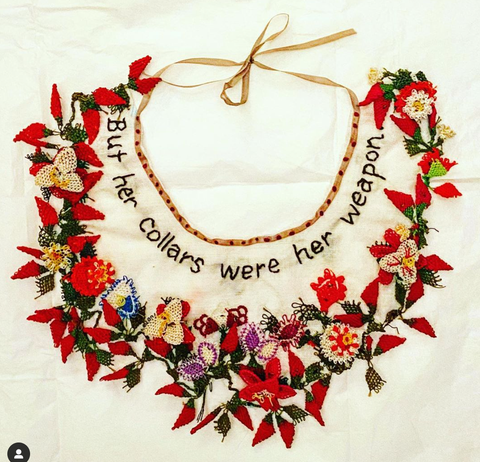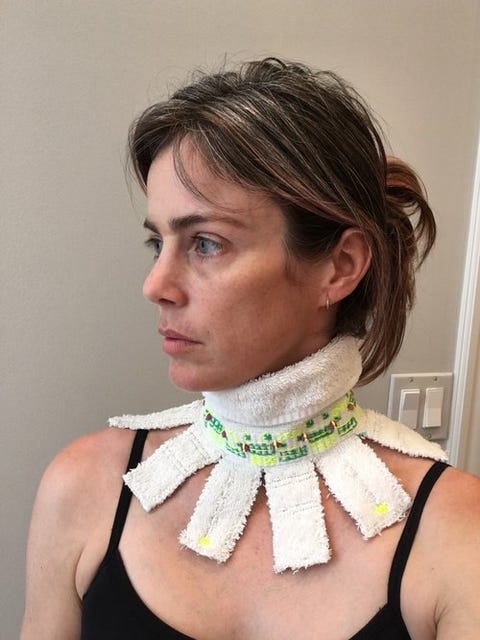When news of Ruth Bader Ginsburg’s passing broke last week, thousands of mourners descended on courthouses across the country to lay flowers and photographs at their steps. Online, the fiber art
community mourned RBG through that symbol she was so famous for: the lace collar.
After their appointments, Ginsburg and Justice Sandra Day O’Connor began wearing the lace “jabot,” worn by judges across Europe and Australia, to contrast with the male justices on the court, who showed a bit of tie through their robes. Today, the other female justices on the court—Elena Kagan and Sonia Sotomayor—have taken to wearing simple collars with their robes, but Ginsburg stood out with her diverse collection of collars. After her death, patterns for “dissent collars” multiplied on the crafting website Ravelry and artists began sharing their quilted and knit tribute pieces on Instagram.
In 2014, Ruth Bader Ginsburg, who had only recently been nicknamed the Notorious RBG, shared her lace collar collection with Katie Couric. In the interview, Ginsburg showed off her dissent and majority opinion collars, and other favorites from around the world. That’s when many fans realized that RBG’s collars not only defined her fashion, but also allowed her to send subtle messages.
The lace community was especially moved by Ginsburg’s love of collars.
“It is so special and so moving for the lace community to have someone in a prestigious role like Justice Ginsburg still embrace collar wearing and lace collars as a symbol of her power and femininity,” said Elena Kanagy-Loux, a collections specialist at the Metropolitan Museum’s Antonio Ratti Textile Center and founder of the Brooklyn Lace Guild.
View this post on InstagramA post shared by Lacis Museum of Lace & Textile (@lacismuseum) on
Lace was not always a feminine accessory—for many centuries it was completely gender neutral—but it was always made mostly by women.
“We do think of the long-suffering lacemaker,” women who worked long hours at low wages, but “the reality was that for many women this was much better paying and much less backbreaking than farm labor, for example,” said Kanagy-Loux.
But because lace production required so many hours of work, manufacturers had to underpay women in order for buyers to be able to afford anything. While male embroiderers organized into guilds, “men in guilds were threatened by having women’s labor entering the workforce in a legitimate way so they actually worked to fight and prevent women from entering guilds and from organizing on their own.”
Many fiber artists honoring RBG today are doing so with antique lace that they’ve inherited—like Diana Weymar.

When Weymar heard news of RBG’s passing, she picked up her needle and thread and embroidered through her grief. As the curator behind The Tiny Pricks Project, a project protesting Donald Trump’s presidency by stitching his words onto antique textiles, Weymar began sharing her RBG textiles to the page’s Instagram. As she shared embroidered collars and jabots, other participants in The Tiny Pricks Project began sending in handkerchiefs and cross-stitch.
“With Ruth Bader Ginsburg you have this feminist who’s feminine,” said Weymar. Something about that “allows people now to bring out their lacy stuff and embroider,” to “embrace this part of their history because they’re celebrating someone who changed history for women.”
Weymar herself inherited a bag of lace from her grandparents and realized that many women had similar collections of handed-down textiles.

“That textile’s made by someone, under some circumstance, for some reason, and how you decide to use it, especially for protest, is a political act,” said Weymar. “What is the connection to our past and to women of our past? How do they fortify and inspire us? This isn’t only a female practice, but women are memory makers. They preserve a lot of domestic history--partly because that was one of the few ways they could tell stories.”
In contrast to these traditional lace collars, some artists like Roxana Geffen have honored RBG by paying tribute to her weighty, gem-studded dissent collar.
The day after the 2016 election, Roxana Geffen was feeling, “like so many other people, just completely devastated.” Then she saw a headline reading “Justice Ginsburg Wears 'Dissent' Collar Following Contentious Election.” At once, she thought it was both a brilliant and subtle gesture, like a “secret message to those of us who needed it.”
In response, Geffen started making her own dissent collars.
I started “cobbling them together with materials that I had on hand in my studio, often while I was listening to the news and feeling enraged and frustrated,” she said. At the time, Geffen felt like her collars were “a gesture of how powerless I felt because I was like, ‘I’m no RBG, I’m just an artist.” But as she began posting photographs of the collars to Instagram, people started responding saying they found them empowering.
“That textile’s made by someone, under some circumstance, for some reason, and how you decide to use it, especially for protest, is a political act.”
Geffen ended up making 24 collars, some woven others and macraméd or embroidered. After the news of Justice Ginsburg’s passing broke, Geffen decided to auction off the collars to raise funds for the ACLU, where Justice Ginsburg spent her formative years as an attorney fighting for women’s rights.
Kanagy-Loux expects that more tribute collars will only continue to emerge in the coming months—after all, lacework can take months to years to complete. In the meantime, Geffen says “it’s been nice to feel a moment of coming together, especially among women, after her death. I feel like there’s been a moment of solidarity."


